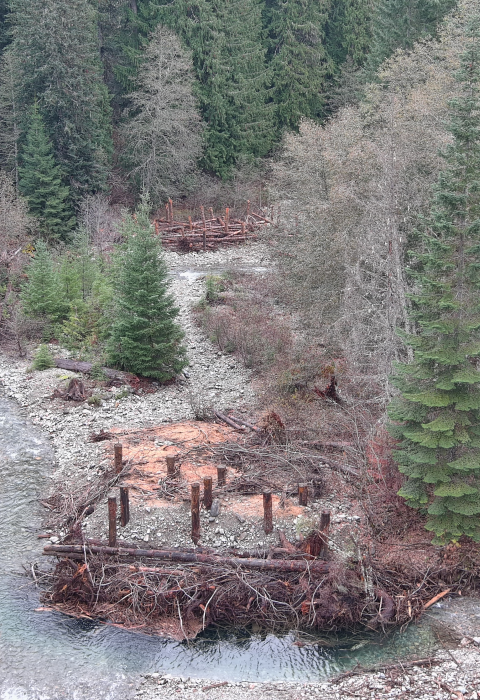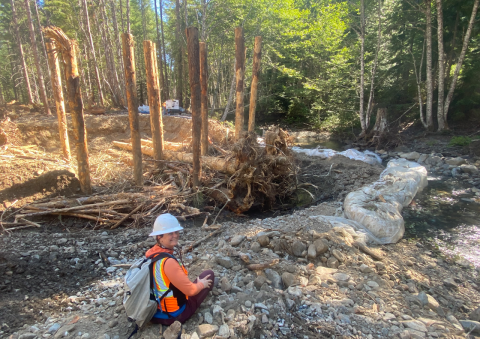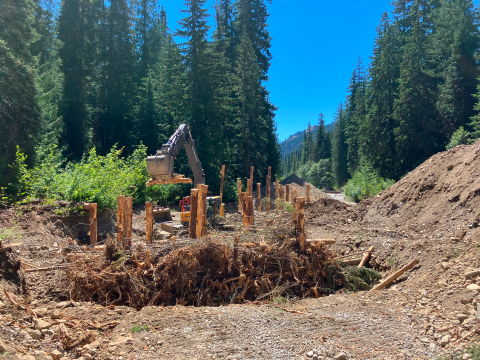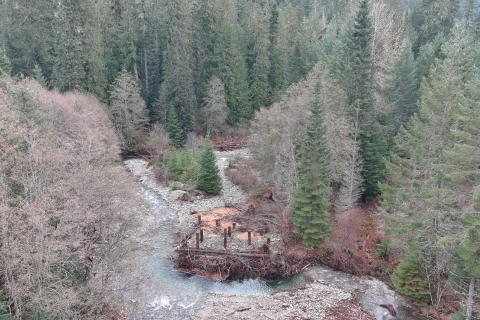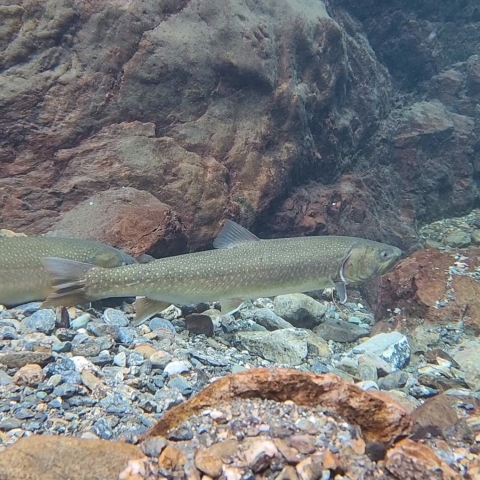In the Pacific Northwest, climate change climate change
Climate change includes both global warming driven by human-induced emissions of greenhouse gases and the resulting large-scale shifts in weather patterns. Though there have been previous periods of climatic change, since the mid-20th century humans have had an unprecedented impact on Earth's climate system and caused change on a global scale.
Learn more about climate change is directly affecting our river systems, and climate models predict unfavorable changes in precipitation and streamflow (flow). More wintertime precipitation is falling as rain instead of snow, resulting in higher, more powerful flows. Without the winter snowpack slowly melting throughout the summer, summer flows are much lower, and these continuously diminishing flows may result in fish passage fish passage
Fish passage is the ability of fish or other aquatic species to move freely throughout their life to find food, reproduce, and complete their natural migration cycles. Millions of barriers to fish passage across the country are fragmenting habitat and leading to species declines. The U.S. Fish and Wildlife Service's National Fish Passage Program is working to reconnect watersheds to benefit both wildlife and people.
Learn more about fish passage barriers in late summer for species that require cold, clean water such as bull trout. While headwater streams are not forecasted to exceed the upper-limit temperatures for cold-water fishes, warmer air temperatures earlier in the season will affect water availability later in the year.
Something temporarily or permanently constructed, built, or placed; and constructed of natural or manufactured parts including, but not limited to, a building, shed, cabin, porch, bridge, walkway, stair steps, sign, landing, platform, dock, rack, fence, telecommunication device, antennae, fish cleaning table, satellite dish/mount, or well head.
Learn more about structure was created to split high flows between the main channel and the high flow side channel, which was also constructed during this project.
The upper Kachess River in Washington is home to a genetically distinct population of federally protected bull trout. Due to the changing climate and decades of human activity such as logging, mining, road building, and dam construction, the lower two miles of the river regularly dries up in summer months. This is due to water flowing below the riverbed, making it inhospitable to aquatic life. The timing and duration of the dry period is problematic to all life stages of bull trout, as adults are unable to migrate upstream to spawn and juveniles become stranded in disconnected pools that eventually dry up. In addition, high winter flows displace and reduce the survival of juvenile bull trout. Consequently, this population of bull trout is in decline and restoration actions are needed to avoid losses that occurred with two of the four neighboring populations of bull trout in the upper Yakima River Basin.
To help address these issues, 1.25 miles of the upper Kachess River were restored in 2023 to improve migratory and rearing conditions for bull trout. The goals of the project were to increase streamflow, maintain connectivity during low flows, and increase floodplain connectivity. To achieve this, 65 large wood structures were built to mimic old growth log jams to create deep pools that bull trout use as holding areas as they move upstream, add cover and complexity to the river, and provide high flow refuge for bull trout. These pools were designed and constructed to connect with the groundwater, providing holding areas during the summer’s dry period. The structures were strategically placed to connect the pools and to narrow the width of the streambed in order to concentrate the low flows, which will help keep the stream watered longer into the summer.
During high flows, the large wood structures will help push water up onto the floodplain, which reduces the power of the flood flows, recharges groundwater aquifers to release water later into the season, provides nutrient exchange, moderates stream temperature, and adds habitat complexity, all of which are vital for bull trout recovery. In addition, a 1,000-foot-high flow side channel was constructed to help reduce the power of flood events and provide juvenile bull trout refugia so they are not flushed downstream into the lake. To increase floodplain connection, a levee was removed at the upstream end of the project, which was originally constructed to prevent flooding during historic logging operations. During the restoration project, two miles of old logging roads were decommissioned, multiple tributaries were restored and reconnected, and the trailhead was relocated out of the floodplain, all to improve floodplain function and connection. Last, but not least, this project seeded over 11 acres and installed over 15,000 native trees and shrubs behind all the large wood structures and on the floodplain to jumpstart riparian riparian
Definition of riparian habitat or riparian areas.
Learn more about riparian and forest growth.
Bull trout are not the only beneficiaries of this restoration project. The entire ecosystem reaps the rewards – from other aquatic organisms, to federally protected northern spotted owls, to all the plants and trees in the forest – as well as humans. Restoring high flows annually into the disconnected floodplain forests will provide water and nutrients to support a healthy forest ecosystem and create resiliency against climate impacts such as seasonal dry spells and prolonged drought.
Restoring bull trout in the Yakima Basin is a highly collaborative effort. While Kittitas Conservation Trust managed the project, U.S. Fish and Wildlife Service, U.S. Forest Service, Yakama Nation, Yakima Basin Integrated Plan, Mid-Columbia Fisheries Bull Trout Task Force, Washington Department of Fish and Wildlife, Mountains to Sound Greenway, Washington Department of Ecology, and the Salmon Recovery Funding Board were all vital partners in the success of this project.
Yakama Nation, WDFW, and the Service monitor the Yakima Basin bull trout populations, providing vital data to make management decisions and direct restoration actions such as the Upper Kachess River Restoration Project. The Service was a partial funder of this restoration project, providing $300K in annual fish passage funding and an additional $71K in staff support and coordination, technical design reviews, and construction oversight during implementation. Yakama Nation leads the Yakima Basin bull trout rescue and rear program, which includes the upper Kachess River bull trout population, and is developing a basin-wide reintroduction plan for bull trout.
While it is too early to determine bull trout response to the project, Yakama Nation, WDFW, and the Service are actively monitoring the results. We are hopeful these restoration efforts will help the upper Kachess bull trout population return to healthy, harvestable levels.
As part of the Leavenworth Fisheries Complex, the Mid-Columbia Fish and Wildlife Conservation Office evaluates the hatchery production programs, provides technical assistance, and assists the coordination of operations and production. The MCFWCO cooperates with other Service programs, agencies, Tribes, and entities using and managing aquatic species and enhancing and restoring aquatic habitat in the mid-and upper-Columbia River Basin.
